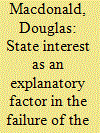| Srl | Item |
| 1 |
ID:
112238


|
|
|
|
|
| Publication |
2012.
|
| Summary/Abstract |
Despite its prominence in the policy discourse, countries of the world have not adopted soft-path energy policy. Current explanations of this failure look to the nature of different fuels, various barriers in the market and political opposition by hard-path energy industries. Such factors provide only partial explanation. The explanation is incomplete because those factors cannot explain the larger subject of the evolution of fuel types during the past two hundred years. For that, we must add the role of the state, through ownership and regulation, in energy generation. That role has expanded regularly with the evolution of fuel types from coal to oil, electricity and nuclear power, but not with the introduction of new renewables in the 1970s. That pattern is explained by the inherent interest of the state in the use of energy for physical, military force and the fact that new renewables have not had immediate military applications. Although renewable energy is increasing, unless the state is motivated for military reasons to play a greater role, the soft-path vision will continue to languish.
|
|
|
|
|
|
|
|
|
|
|
|
|
|
|
|
| 2 |
ID:
125657


|
|
|
|
|
| Publication |
2013.
|
| Summary/Abstract |
Cement is the second largest anthropogenic emission source, contributing approximately 7% of global CO2 emissions. Carbon dioxide capture and storage (CCS) technology is considered by the International Energy Agency (IEA) as an essential technology capable of reducing CO2 emissions in the cement sector by 56% by 2050. The study compares CO2 capture technologies for the cement manufacturing process and analyses the economic and financial issues in deploying CO2 capture in the cement industry. Post-combustion capture with chemical absorption is regarded as a proven technology to capture CO2 from the calcination process. Oxyfuel is less mature but Oxyfuel partial capture-which only recycles O2/CO2 gas in the precalciner-is estimated to be more economic than post-combustion capture. Carbonate looping technologies are not yet commercial, but they have theoretical advantages in terms of energy consumption. In contrast with coal-fired power plants, CO2 capture in the cement industry benefits from a higher concentration of CO2 in the flue gas, but the benefit is offset by higher SOx and NOx levels and the smaller scale of emissions from each plant. Concerning the prospects for financing cement plant CO2 capture, large cement manufacturers on average have a higher ROE (return on equity) and lower debt ratio, thus a higher discount rate should be considered for the cost analysis than in power plants. IEA estimates that the incremental cost for deploying CCS to decarbonise the global cement sector is in the range US$350-840 billion. The cost estimates for deploying state-of-the art post-combustion CO2 capture technologies in cement plants are above $60 to avoid each tonne of CO2 emissions. However, the expectation is that the current market can only provide a minority of financial support for CO2 capture in cement plants. Public financial support and/or CO2 utilisation will be essential to trigger large-scale CCS demonstration projects in the cement industry.
|
|
|
|
|
|
|
|
|
|
|
|
|
|
|
|